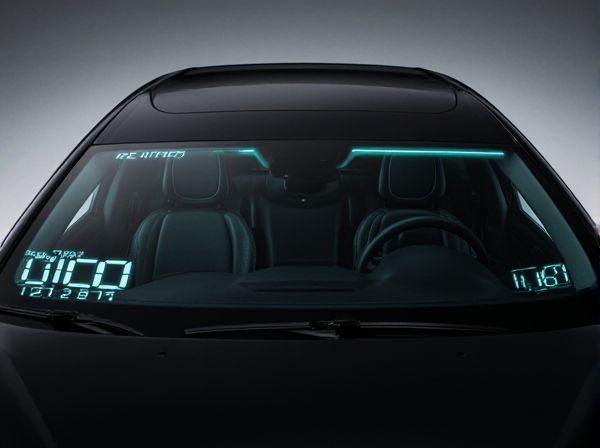
Photo illustration: Heads-Up Display Windshield vs Non-HUD Windshield
A Heads-Up Display (HUD) windshield projects critical information directly onto the glass, allowing you to stay focused on the road without diverting your eyes. In contrast, non-HUD windshields do not feature this technology, requiring drivers to glance down at dashboard gauges or infotainment screens. Choosing an HUD windshield enhances safety and convenience by delivering real-time data within your natural line of sight.
Table of Comparison
| Feature | Heads-Up Display (HUD) Windshield | Non-HUD Windshield |
|---|---|---|
| Display Technology | Projects vital info onto windshield | No built-in display functionality |
| Driver Safety | Enhances focus by minimizing eye movement | Requires driver to look away for info |
| Information Shown | Speed, navigation, alerts, and diagnostics | Only visible via dashboard instruments |
| Cost | Higher initial vehicle cost | Generally lower cost |
| Installation | Integrated or aftermarket options available | Standard windshield installation |
| Visibility | May reduce glare and reflections with anti-reflective coating | Standard visibility without display enhancements |
Introduction to HUD and Non-HUD Windshields
Heads-Up Display (HUD) windshields integrate transparent displays that project critical driving information directly onto the glass, enhancing driver safety and convenience by minimizing distractions. Non-HUD windshields serve as standard transparent barriers without embedded digital displays, relying on traditional dashboard instruments for information delivery. The adoption of HUD technology represents a significant advancement in automotive user interface design, promoting real-time data accessibility without diverting driver attention.
What is a Heads-Up Display (HUD) Windshield?
A Heads-Up Display (HUD) windshield projects critical driving information directly onto the glass, allowing drivers to see data such as speed, navigation, and alerts without looking away from the road. Unlike non-HUD windshields, which serve solely as protective glass, HUD windshields integrate transparent display technology to enhance safety and convenience. This technology reduces distraction by keeping essential information within the driver's line of sight.
How Do Non-HUD Windshields Differ?
Non-HUD windshields lack the integrated projection technology found in HUD windshields, meaning they do not display real-time information such as speed, navigation, or alerts directly in the driver's line of sight. Traditional non-HUD windshields primarily serve as a protective barrier without the embedded electronics and reflective layers required for heads-up displays. This fundamental difference affects driver focus and safety, as HUD windshields minimize the need to look away from the road.
Key Features of HUD Windshields
Heads-up display (HUD) windshields project critical driving information such as speed, navigation, and safety alerts directly onto the glass, allowing drivers to keep their eyes on the road and reduce distraction. Advanced HUD windshields utilize augmented reality (AR) technology to overlay real-time data in a spatially relevant manner, enhancing situational awareness during complex driving conditions. Unlike traditional non-HUD windshields, HUDs integrate seamlessly with vehicle sensors and GPS systems, delivering customizable, dynamic visual cues that improve overall driving safety and convenience.
Pros and Cons of HUD Windshields
HUD windshields project critical driving information such as speed, navigation, and warnings directly onto the glass, reducing the need for drivers to look away from the road and enhancing safety and convenience. One drawback is the higher cost and potential distraction if the display is overly bright or cluttered, which may impact driver focus. Non-HUD windshields lack this integrated technology, relying on traditional dashboard displays that can divert attention from the road but typically come at a lower price point.
Advantages and Limitations of Non-HUD Windshields
Non-HUD windshields offer cost-effective manufacturing and simpler design without the integration of projection systems, making them more accessible for standard vehicles. Limitations include reduced driver situational awareness due to the absence of real-time data projections directly in the line of sight, which may lead to increased distraction or slower reaction times. They lack augmented reality features that improve navigation and safety, which are inherent advantages of HUD windshields providing vital information without diverting attention from the road.
Safety and Driving Experience Comparison
Heads-Up Display (HUD) windshields enhance safety by projecting critical driving information directly onto the glass, allowing drivers to keep their eyes on the road and reduce distraction. Non-HUD windshields require drivers to glance down at the dashboard, increasing reaction times and the risk of accidents. HUD technology improves driving experience by providing real-time data such as speed, navigation, and alerts within the driver's line of sight, promoting more attentive and informed driving.
Cost Differences: HUD vs Non-HUD Windshields
Heads-Up Display (HUD) windshields generally cost significantly more than non-HUD windshields due to the integrated projection technology that allows important driving information to be displayed directly on the glass. The manufacturing process for HUD windshields requires specialized materials and electronics, increasing both production and replacement costs compared to standard windshields. Insurance and repair expenses also tend to be higher for HUD windshields because of the complexity involved in calibration and sensor integration.
Maintenance and Durability Considerations
Heads-up display (HUD) windshields require specialized cleaning products to avoid damaging the transparent display layer, which is more delicate than regular glass. Maintenance of HUD windshields should avoid abrasive materials and high-pressure washing to preserve their functionality and optical clarity. Non-HUD windshields are generally more durable and easier to maintain with standard glass cleaners, making them less costly over time in terms of upkeep and repairs.
Which Windshield is Right for You?
Choosing between a Heads-Up Display (HUD) windshield and a non-HUD windshield depends on your driving preferences and safety priorities. HUD windshields project important information like speed and navigation directly onto the glass, minimizing distractions and allowing you to keep your eyes on the road. Non-HUD windshields are more traditional, often more affordable, and may be preferable if you do not require real-time data display or prefer a simpler driving experience.
 caratoz.com
caratoz.com